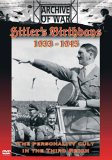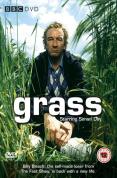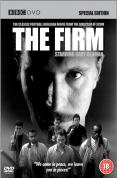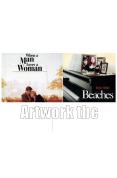 The Moguls/The Big Lebowski | DVD | (18/09/2006)
from £11.30
| Saving you £13.69 (54.80%)
| RRP
The Moguls/The Big Lebowski | DVD | (18/09/2006)
from £11.30
| Saving you £13.69 (54.80%)
| RRP The Big Lebowski (Dir. Joel Coen 1998): 'The Dude' Jeff Lebowski (Jeff Bridges) is unemployed and as laid-back as they come. That is until he becomes a victim of mistaken identity when two thugs break into his apartment with the errant belief that they're strong-arming Jeff Lebowski - the Pasadena millionaire. In the hope of getting a replacement for his soiled carpet 'the Dude' pays a visit to his wealthy namesake... It's not long before 'The Dude' and his psychopathic buddy Walter Sobchak (John Goodman) are drawn into a labyrinthine plot of extortion embezzlement sex dope German Nihilists White Russians mysterious cowboys Shomer Shabbos bowling and severed toes... Envisaged as a homage to the musicals of Busby Berkley Robert Altman's The Long Goodbye (adapted from Raymond Chandler's novel) and the ritual of bowling The Big Lebowski has developed a massive cult-following with its hilarious dialogue and quirky characters. Apparently the script was written with Jeff Bridges John Goodman and Sam Elliott in mind... Jeff Bridges even went as far as to say he could have turned out like 'The Dude' had he not been born into the movie business... Sounds good to us man! The Moguls (Dir. Michael Traeger 2005): In a nothing bar in a small nowhere industrial town sits Andy - a nice guy down on his luck. Jobs have come and gone. Crazy moneymaking enterprises have crumbled to dust. His ex-wife has married a rich guy who can buy his only son all the things that Andy can't afford. All Andy's got is a bunch of loving loser friends and a desire to do something to change his destiny. Staring morosely at the small ads in the town paper it comes to him in a flash - he'll make a porno film - with his friends!
 Hitler's Birthdays 1933 - 1945 | DVD | (17/04/2004)
from £N/A
| Saving you £N/A (N/A%)
| RRP
Hitler's Birthdays 1933 - 1945 | DVD | (17/04/2004)
from £N/A
| Saving you £N/A (N/A%)
| RRP The history of the 'Fuhrer's Birthdays' from 1933 to 1945 and the effects of them on the German people.
 Grass | DVD | (30/09/2007)
from £20.00
| Saving you £-4.01 (N/A%)
| RRP
Grass | DVD | (30/09/2007)
from £20.00
| Saving you £-4.01 (N/A%)
| RRP Grass marks a welcome return for The Fast Show's overzealous know-it-all Billy Bleach. Written by (along with Andrew Collins) and starring Simon Day he actually created the character of Billy almost ten years ago for use in his stand up routines. After witnessing a gangland murder self-made loser Billy Bleach is forced to grass on villain Harry Taylor and is given a new identity. How will he cope in the village of Little Mockwell in deepest rural Norfo
![Wire In The Blood - Series 1 [2002]](/pictures/1018538.jpg) Wire In The Blood - Series 1 | DVD | (26/01/2004)
from £N/A
| Saving you £N/A (N/A%)
| RRP
Wire In The Blood - Series 1 | DVD | (26/01/2004)
from £N/A
| Saving you £N/A (N/A%)
| RRP  Roger Roger - Complete Series 1 And 2 | DVD | (10/04/2006)
from £20.00
| Saving you £9.99 (49.95%)
| RRP
Roger Roger - Complete Series 1 And 2 | DVD | (10/04/2006)
from £20.00
| Saving you £9.99 (49.95%)
| RRP Available for the first time on DVD John Sullivan's comedy series set in and around the office of Cresta Cabs is a welcome sight indeed. Stressed-out and drained by his ever-weird workforce Sam (Robert Daws) desperately tries to keep his employees in line whilst promoting - in his opinion - the good name of the company. However the business would have sunk along time ago if it wasn't for the efforts of Sam's right-hand woman Reen (Pippa Guard). Mind you even Pippa's going to have trouble with this motley rabble! Episodes Comprise: 1. Even Quasimodo Pulled 2. I Used To Be A Superb Rugby Player 3. Socks With Little Tennis Players On Them 4. There Are No Minicabs In Heaven 5. Some Get The Magic Some Get The Tragic 6. The Day The Music Died 7. Welcome To Responsibilityville 8. Every Victim Wishes He'd Kept His Clothes On 9. Sometimes It's Hard To Be A Man 10. Ask The 1975 Millwall Defence 11. I'm Not A Little Baby And Daddy Hasn't Gone To Japan 12. Too Much Wine Too Many Stars 13. Love Rules The Heart Money Takes The Soul
![Alan Clarke Collection [DVD]](/pictures/1130044.jpg) Alan Clarke Collection | DVD | (31/10/2005)
from £N/A
| Saving you £N/A (N/A%)
| RRP
Alan Clarke Collection | DVD | (31/10/2005)
from £N/A
| Saving you £N/A (N/A%)
| RRP Scum (1979): Raw, violent and shocking, Scum is a compelling story set in a contemporary Borstal. It tells of life in an institution run by violence and brutality rather than reason, where the boy who can fight his way to the top of the heap and reign as 'Daddy' will gain the respect of the inmates and sadistic 'screws' alike. One of the most controversial films ever made in the UK, and one which caused a huge furore when it was first screened on TV, Scum s...
![The Bounty [UMD Universal Media Disc]](/pictures/1036780.jpg) The Bounty | UMD | (01/01/1980)
from £N/A
| Saving you £N/A (N/A%)
| RRP
The Bounty | UMD | (01/01/1980)
from £N/A
| Saving you £N/A (N/A%)
| RRP ![The Stranger [1946]](/pictures/1012075.jpg) The Stranger | DVD | (02/02/2004)
from £N/A
| Saving you £N/A (N/A%)
| RRP
The Stranger | DVD | (02/02/2004)
from £N/A
| Saving you £N/A (N/A%)
| RRP The Stranger, according to Orson Welles, "is the worst of my films. There is nothing of me in that picture. I did it to prove that I could put out a movie as well as anyone else." True, set beside Citizen Kane, Touch of Evil, or even The Trial, The Stranger is as close to production-line stuff as the great Orson ever came. But even on autopilot Welles still leaves most filmmakers standing. The shadow of the Second World War hangs heavy over the plot. A war crimes investigator, played by Edward G Robinson, tracks down a senior Nazi, Franz Kindler, to a sleepy New England town where he's living in concealment as a respected college professor. The script, credited to Anthony Veiller but with uncredited input from Welles and John Huston, is riddled with implausibilities: we're asked to believe, for a start, that there'd be no extant photos of a top Nazi leader. The casting's badly skewed, too. Welles wanted Agnes Moorehead as the investigator and Robinson as Kindler, but his producer, Sam Spiegel, wouldn't wear it. So Welles himself plays the supposedly cautious and self-effacing fugitive--and if there was one thing Welles could never play, it was unobtrusive. What's more, Spiegel chopped out most of the two opening reels set in South America, in Welles' view, "the best stuff in the picture". Still, the film's far from a write-off. Welles' eye for stunning visuals rarely deserted him and, aided by Russell Metty's skewed, shadowy photography, The Stranger builds to a doomy grand guignol climax in a clock tower that Hitchcock must surely have recalled when he made Vertigo. And Robinson, dogged in pursuit, is as quietly excellent as ever. On the DVD: not much in the way of extras, except a waffly full-length commentary from Russell Cawthorne that tells us about the history of clock-making and where Edward G was buried, but precious little about the making of the film. Print and sound are acceptable, but though remastering is claimed, there's little evidence of it. --Philip Kemp
![John Wayne Classics - The Lucky Texan / West Of The Divide [1935]](/pictures/1003466.jpg) John Wayne Classics - The Lucky Texan / West Of The Divide | DVD | (18/03/2002)
from £N/A
| Saving you £N/A (N/A%)
| RRP
John Wayne Classics - The Lucky Texan / West Of The Divide | DVD | (18/03/2002)
from £N/A
| Saving you £N/A (N/A%)
| RRP ![North by Northwest (Deluxe Series) [1959]](/pictures/1012733.jpg) North by Northwest (Deluxe Series) | DVD | (16/09/2002)
from £N/A
| Saving you £N/A (N/A%)
| RRP
North by Northwest (Deluxe Series) | DVD | (16/09/2002)
from £N/A
| Saving you £N/A (N/A%)
| RRP Cary Grant teams with Hitchcock for the fourth and final time in this superlative espionage caper judged one of the American Film Institute's Top 100 American Films and spruced up with a new digital transfer and remixed Dolby Surround Stereo. Grant plays a Manhattan advertising executive plunged into a realm of spy (James Mason) and counterspy (Eva Marie Saint) and variously abducted framed for murder chased and in another signature set piece crop-dusted. He also holds on for dear life from that famed carved rock (for which back lot sets were used). But don't expect the Master Of Suspense to leave star or audience hanging...
![Creepshow 2 [1987]](/pictures/1022859.jpg) Creepshow 2 | DVD | (11/02/2002)
from £N/A
| Saving you £N/A (N/A%)
| RRP
Creepshow 2 | DVD | (11/02/2002)
from £N/A
| Saving you £N/A (N/A%)
| RRP For Creepshow 2, the quickie 1987 sequel to the Stephen King-scripted/George Romero-directed 1982 original, Romero shifted jobs to become the screenwriter, earning King (who also has a goony cameo as a trucker) a "based on stories by" credit. Cinematographer Michael Gornick stepped up to make an uninspiring directorial debut, turning out a conventional TV-look picture unlike the sometimes striking Creepshow. A frame story mixes live action and cartoon as a small boy leafs through the latest issue of his favourite horror comic while plotting revenge against neighbourhood bullies. A pun-dropping host called the Creep (played by Tom Savini when not a cartoon) introduces three anecdotes. In "Old Chief Wooden Head", George Kennedy and Dorothy Lamour are kindly Western shopkeepers killed by tearaways and avenged by the wooden Indian which stands outside the place. In "The Raft", four obnoxious teens are terrorised on a lake by a hungry slime-monster. And in "The Hitch-Hiker", hit-and-run driver Lois Chiles is haunted by her squashed victim, who keeps reappearing in a progressively battered forms. Though King and Romero deliver a good mix of cynical and melodramatic dialogue, the stories are disappointingly thin and predictable, with especially weak punch-lines. Of the performers, only Chiles really works up the hysterical attack needed to play a comic book character. On the DVD: just a trailer. The picture is a fullscreen print that cuts off crucial details in the comic book panels. --Kim Newman
 The Firm | DVD | (21/08/2006)
from £N/A
| Saving you £N/A (N/A%)
| RRP
The Firm | DVD | (21/08/2006)
from £N/A
| Saving you £N/A (N/A%)
| RRP ![Stephane Grappelli - Fascinating Rhythm [Dutch Import]](/pictures/1045212.jpg) Stephane Grappelli - Fascinating Rhythm | DVD | (16/08/2004)
from £4.75
| Saving you £27.01 (85.00%)
| RRP
Stephane Grappelli - Fascinating Rhythm | DVD | (16/08/2004)
from £4.75
| Saving you £27.01 (85.00%)
| RRP Stephane Grappelli - Fascinating Rhythm
 Beaches/When A Man Loves A Woman | DVD | (05/11/2007)
from £N/A
| Saving you £N/A (N/A%)
| RRP
Beaches/When A Man Loves A Woman | DVD | (05/11/2007)
from £N/A
| Saving you £N/A (N/A%)
| RRP Beaches: (Dir. Garry Marshall) (1988): Two very different young girls meet on a beach in a 1950s American resort. CC Bloom (Bette Midler) is a brash confident minx determined to make it in the glitzy world of show business. Hillary (Barbara Hershey) is a wealthy restrained and privileged WASP who seems destined for a life as a trophy wife. Against all odds their friendship survives through broken marriages diverging careers and the trials of life. When A Man Loves A Woman: (Dir. Luis Mandoki) (1997): Alice and Michael Green are a passionate couple who have worked hard to build a good life for themselves and their two young daughters. But a dark secret from Alice's past is about to surface - a secret that threatens to destroy them as lovers as a family and as individuals.
![Credo [DVD]](/pictures/1092477.jpg) Credo | DVD | (25/05/2009)
from £N/A
| Saving you £N/A (N/A%)
| RRP
Credo | DVD | (25/05/2009)
from £N/A
| Saving you £N/A (N/A%)
| RRP Following a wild party five friends are evicted from their student digs and are forced to seek refuge in an abandoned hall of residence in central London. They soon sense they're not alone and recall the story of a ritual group suicide that occurred in that same building a few years before. When they conduct a s''ance to uncover the reason behind the suicides the answer comes not from the ghosts of dead students but from the terrifying entity that drove them to their deaths. And now it knows they're here it's not going to let them leave.
![Mike Bassett: England Manager [UMD Universal Media Disc] [2001]](/pictures/1036188.jpg) Mike Bassett: England Manager | UMD | (01/01/1980)
from £N/A
| Saving you £N/A (N/A%)
| RRP
Mike Bassett: England Manager | UMD | (01/01/1980)
from £N/A
| Saving you £N/A (N/A%)
| RRP Ricky Tomlinson - star of TV's "The Royle Family" - plays football manager Mike Bassett in this spoof documentary that follows the turn of events after he becomes manager of England's international football team - because no one else wants the job!
 Kate And Leopold/Serendipity | DVD | (05/11/2007)
from £N/A
| Saving you £N/A (N/A%)
| RRP
Kate And Leopold/Serendipity | DVD | (05/11/2007)
from £N/A
| Saving you £N/A (N/A%)
| RRP Kate And Leopald: (Dir. James Mangold) (2001): Carried through time to modern-day Manhattan 18th century English aristocrat and inventor Leopold (Hugh Jackman) falls for independent and career-minded Kate (Meg Ryan). Initially skeptical of his royal charm she soon discovers that the Duke's power over her own heart is almost as strong as his influence over time itself... Serendipity: (Dir: Peter Chelsom) (2001): In one magical moment Jonathan Trager and Sara Thomas meet unexpectedly and spend a romantic winter day together although both are involved with other people. At the end of the night Sara decides they must let fate determine if they are meant to be together and disappears without giving Jonathan a way of reaching her. Years later they are both engaged to others but cannot give up the dream that they will meet again. And so begins their journey to find one another worlds apart!
![The Lord of the Rings: The Return of the King (Extended Edition) [VHS]](/pictures/1095623.jpg) The Lord of the Rings: The Return of the King (Extended Edition) | DVD | (10/12/2004)
from £N/A
| Saving you £N/A (N/A%)
| RRP
The Lord of the Rings: The Return of the King (Extended Edition) | DVD | (10/12/2004)
from £N/A
| Saving you £N/A (N/A%)
| RRP The greatest trilogy in film history, presented in the most ambitious sets in DVD history, comes to a grand conclusion with the extended edition of The Lord of the Rings: The Return of the King. Not only is the third and final installment of Peter Jackson's adaptation of the works of J.R.R. Tolkien the longest of the three, but a full 50 minutes of new material pushes the running time to a whopping 4 hours and 10 minutes. The new scenes are welcome, and the bonus features maintain the high bar set by the first two films, The Fellowship of the Ring and The Two Towers. What's New? One of the scenes cut from the theatrical release but included here, the resolution of the Saruman storyline, generated a lot of publicity when the movie opened, as actor Christopher Lee complained in the press about losing his only appearance. It's an excellent scene, one Jackson calls "pure Tolkien," and provides better context for Pippin to find the wizard's palantir in the water, but it's not critical to the film. In fact, "valuable but not critical" might sum up the ROTK extended edition. It's evident that Jackson made the right cuts for the theatrical run, but the extra material provides depth and ties up a number of loose ends, and for those sorry to see the trilogy end (and who isn't?) it's a welcome chance to spend another hour in Middle-earth. Some choice moments are Gandalf's (Ian McKellen) confrontation with the Witch King (we find out what happened to the wizard's staff), the chilling Mouth of Sauron at the gates of Mordor, and Frodo (Elijah Wood) and Sam (Sean Astin) being mistaken for Orc soldiers. We get to see more of Éowyn (Miranda Otto), both with Aragorn and on the battlefield, even fighting the hideously deformed Orc lieutenant, Gothmog. We also see her in one of the most anticipated new scenes, the Houses of Healing after the battle of the Pelennor Fields. It doesn't present Aragorn (Viggo Mortensen) as a savior as the book did, but it shows the initial meeting between Éowyn and Faramir (David Wenham), a relationship that received only a meaningful glance in the theatrical cut. If you want to completely immerse yourself in Peter Jackson's marvelous and massive achievement, only the extended edition will do. And for those who complained, no, there are no new endings, not even the scouring of the Shire, which many fans were hoping to see. Nor is there a scene of Denethor (John Noble) with the palantir, which would have better explained both his foresight and his madness. As Jackson notes, when cuts are made, the secondary characters are the first to go, so there is a new scene of Aragorn finding the palantir in Denethor's robes. Another big difference is Aragorn's confrontation with the King of the Dead. In the theatrical version, we didn't know whether the King had accepted Aragorn's offer when the pirate ships pulled into the harbor; here Jackson assumes that viewers have already experienced that tension, and instead has the army of the dead join the battle in an earlier scene (an extended cameo for Jackson). One can debate which is more effective, but that's why the film is available in both versions. If you feel like watching the relatively shorter version you saw in the theaters, you can. If you want to completely immerse yourself in Peter Jackson's marvelous and massive achievement, only the extended edition will do. How Are the Bonus Features? To complete the experience, The Return of the King provides the same sprawling set of features as the previous extended editions: four commentary tracks, sharp picture and thrilling sound, and two discs of excellent documentary material far superior to the recycled material in the theatrical edition. Those who have listened to the seven hours of commentary for the first two extended editions may wonder if they need to hear more, but there was no commentary for the earlier ROTK DVD, so it's still entertaining to hear him break down the film (he says the beacon scene is one of his favorites), discuss differences from the book, point out cameos, and poke fun at himself and the extended-edition concept ("So this is the complete full strangulation, never seen before, here exclusively on DVD!"). The documentaries (some lasting 30 minutes or longer) are of their usual outstanding quality, and there's a riveting storyboard/animatic sequence of the climactic scene, which includes a one-on-one battle between Aragorn and Sauron. One DVD Set to Rule Them All Peter Jackson's trilogy has set the standard for fantasy films by adapting the Holy Grail of fantasy stories with a combination of fidelity to the original source and his own vision, supplemented by outstanding writing, near-perfect casting, glorious special effects, and evocative New Zealand locales. The extended editions without exception have set the standard for the DVD medium by providing a richer film experience that pulls the three films together and further embraces Tolkien's world, a reference-quality home theater experience, and generous, intelligent, and engrossing bonus features. --David Horiuchi
![I.D. [DVD] [1994]](/pictures/1101262.jpg) I.D. | DVD | (16/08/2010)
from £20.59
| Saving you £N/A (N/A%)
| RRP
I.D. | DVD | (16/08/2010)
from £20.59
| Saving you £N/A (N/A%)
| RRP When you go undercover remember one thing: who you are. In an effort to halt the escalating violence of fanatical football supporters four young policemen are sent undercover. One of these John (Reece Dinsdale) soon finds his own personality changing and feels a sense of belonging he never felt on the force...
 Mission: Impossible 3 | DVD | (13/11/2006)
from £10.98
| Saving you £16.00 (177.98%)
| RRP
Mission: Impossible 3 | DVD | (13/11/2006)
from £10.98
| Saving you £16.00 (177.98%)
| RRP Tom Cruise returns as Special Agent Ethan Hunt, who faces the mission of his life.

Please wait. Loading...
This site uses cookies.
More details in our privacy policy